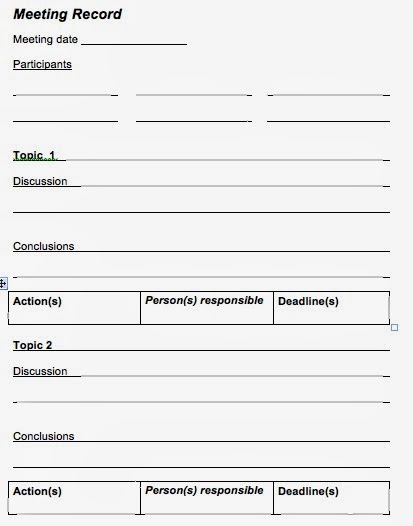Jack Pyle's Blog
Tips to improve your personal and business life.
Monday, October 30, 2017
Wednesday, January 29, 2014
Tip 6 of 7 Tips for Effective Meetings
Evaluate the meeting
 Never end a meeting without taking time to work on improving future meetings. You do this by discussing what went well and what could be done to make the next meeting better. Often when meetings are running late, you may feel their isn’t time for evaluation. Resist the urge to end the meeting without evaluating it.
Never end a meeting without taking time to work on improving future meetings. You do this by discussing what went well and what could be done to make the next meeting better. Often when meetings are running late, you may feel their isn’t time for evaluation. Resist the urge to end the meeting without evaluating it.
Evaluating the meeting will help to improve future meetings!
When all are involved in discussion about the meeting before it ends, everyone will start to recognize those things that make a meeting worthwhile. Also discuss ideas to improve future meetings. Then keep doing what is working and stop doing what is not working.
Evaluate overall meeting effectiveness
Start the evaluation process by asking “What was most valuable about this meeting?” Wait for answers. Long pauses after a question give people time to think about their responses. Many times in meetings I have observed the meeting facilitator ask a question and then go on quickly when there are no immediate answers.
You can follow this question with “What happened during the meeting that was not helpful?”
Some other thought starters for meeting evaluations are:
Ask for feedback about how the meeting leader can be a better group facilitator at meetings. Encourage negative comments. Make sure you ask for complete honesty and assure members there will be no reprisals for their answers. Listen carefully, and don’t react as though you are not willing to accept helpful critical feedback.
Questions you might ask are:
Ask for feedback about the behaviors of everyone attending the meeting.
Get agreement of changes you want to make in future meetings
Make a record of changes you want to make for the next meeting in the meeting minutes so that you will remember them.
P.S. Add your ideas for effective meeting evaluations in the "Comments" area below. Share what you like about your meetings and what you would like to see changed.
 Never end a meeting without taking time to work on improving future meetings. You do this by discussing what went well and what could be done to make the next meeting better. Often when meetings are running late, you may feel their isn’t time for evaluation. Resist the urge to end the meeting without evaluating it.
Never end a meeting without taking time to work on improving future meetings. You do this by discussing what went well and what could be done to make the next meeting better. Often when meetings are running late, you may feel their isn’t time for evaluation. Resist the urge to end the meeting without evaluating it. Evaluating the meeting will help to improve future meetings!
When all are involved in discussion about the meeting before it ends, everyone will start to recognize those things that make a meeting worthwhile. Also discuss ideas to improve future meetings. Then keep doing what is working and stop doing what is not working.
Evaluate overall meeting effectiveness
Start the evaluation process by asking “What was most valuable about this meeting?” Wait for answers. Long pauses after a question give people time to think about their responses. Many times in meetings I have observed the meeting facilitator ask a question and then go on quickly when there are no immediate answers.
You can follow this question with “What happened during the meeting that was not helpful?”
Some other thought starters for meeting evaluations are:
- What can we do to improve the next meeting for you?
- How can we improve our decision-making process in future meetings?
- What can we do to improve teamwork in meetings?
- How can we get more participation from everyone in the meeting?
Ask for feedback about how the meeting leader can be a better group facilitator at meetings. Encourage negative comments. Make sure you ask for complete honesty and assure members there will be no reprisals for their answers. Listen carefully, and don’t react as though you are not willing to accept helpful critical feedback.
Questions you might ask are:
- What can I do differently in future meetings to help us get better results?
- What do I do that you like and want me to continue in future meetings?
- Do I have behaviors that stifle openness?
Ask for feedback about the behaviors of everyone attending the meeting.
- What behaviors of meeting participants helped to move our discussions forward positively?
- What behaviors wasted time, took us away from the agenda item being discussed, or took more time than necessary?
Get agreement of changes you want to make in future meetings
Make a record of changes you want to make for the next meeting in the meeting minutes so that you will remember them.
P.S. Add your ideas for effective meeting evaluations in the "Comments" area below. Share what you like about your meetings and what you would like to see changed.
Monday, January 20, 2014
Tip 5 of 7 Tips for Effective Meetings
Create simple meeting minutes
Many meeting minutes I have seen are in long paragraphs with no easy way to find what you are looking for later in reviewing minutes to discover:
1. What was decided?
2. Who is responsible for action items?
3. What are deadlines were established?
Here’s a simple way to keep minutes.

Most people don’t like to take meeting minutes. Following this meeting record template makes it easy. While this won’t work for all meetings, it will be effective for most of them.
This form is not only easy to use for the person who takes minutes. It also makes it quick and easy to review in the future. It is easy to find:
1. The meeting date and who attended
2. Topics of discussion, which are underlined in bold
3. Brief notes of what was discussed
4. Conclusions made at the end of discussion
5. Action steps, responsibility to achieve them and deadlines for the work
Future action step are obvious because they are in boxes to stand out.
You can find many other meeting templates on Google. Here’s the link:
http://www.wordtemplatesonline.com/2011/01/meeting-minutes-templates/
Many meeting minutes I have seen are in long paragraphs with no easy way to find what you are looking for later in reviewing minutes to discover:
1. What was decided?
2. Who is responsible for action items?
3. What are deadlines were established?
Here’s a simple way to keep minutes.

Most people don’t like to take meeting minutes. Following this meeting record template makes it easy. While this won’t work for all meetings, it will be effective for most of them.
This form is not only easy to use for the person who takes minutes. It also makes it quick and easy to review in the future. It is easy to find:
1. The meeting date and who attended
2. Topics of discussion, which are underlined in bold
3. Brief notes of what was discussed
4. Conclusions made at the end of discussion
5. Action steps, responsibility to achieve them and deadlines for the work
Future action step are obvious because they are in boxes to stand out.
You can find many other meeting templates on Google. Here’s the link:
http://www.wordtemplatesonline.com/2011/01/meeting-minutes-templates/
Thursday, December 19, 2013
Tip 4 of 7 Tips for Effective Meetings
 Learn to be a good meeting facilitator and keep meetings on time
Learn to be a good meeting facilitator and keep meetings on time1. Maintain control of the agenda
Your job as meeting facilitator is crucial for effective meetings. It’s up to you to direct attention back to the topic when it strays (and it will). It is common for people to stray from the agenda topic. As the meeting facilitator, it is your job to be a traffic cop and get the conversation focused back on the current item of discussion. Be ruthless about it as a good facilitator. Your team will eventually learn to stay on topic.
2. Don’t go beyond the time set for each agenda item
Keep people focused on using time wisely. Appoint a timekeeper and ask them to announce a two-minute or five-minute warning when nearing the time limit for each item on the agenda. Have different people serve as timekeeper at each meeting, which reinforces the importance of timing to individuals. (Only go beyond time limit when everyone agrees. But don't do it too often.)
I once helped the executive team of a healthcare organization to improve their staff meetings. I asked the CEO to quit leading all meetings. He had a tendency to talk way too much. He said he tried that once and it didn’t work out well. Do it again, I insisted. I said it is a great way for your key executives to learn meeting facilitation skills. I recommended the timekeeper become the next meeting facilitator. A couple of months later I asked an executive vice president how the meetings were going. He told me that with a timekeeper and new facilitator at each meeting they were accomplishing about three times as much as they had formerly.
3. Stop side conversations
It’s normal for side conversations to start during meetings. Often people get excited about the topic and start talking to each other while the rest of the group is discussing the agenda topic. My favorite response when this happens is to say: “We have two meetings going on. Let’s have one meeting.” That gets everyone‘s attention back on the person currently speaking.
4. Watch out for repetition of ideas
One good technique is to briefly summarize what has been said. Anyone at the meeting can do this, though it is a key role for the meeting facilitator. This is good to do when people give too many details or repeat what they have already said. While observing meetings for my clients to improve meeting effectiveness I often have heard the same point made by the same person several times in different ways. Restating it briefly gets the meeting back on track.
5. Always start meetings on time
It is a terrible waste of human resources and money if 6-8 people are waiting 10-25 minutes to start a meeting because some have not arrived. Build an on-time culture for meetings. Soon you will notice that people DO arrive on time.
Share your additional ideas for being a good facilitator in Comments below. Thanks for sharing!
www.JackPyle.com
Monday, December 16, 2013
Tip 3 of 7 Tips for Effective Meetings
Always use an agenda.
This is a good way to keep yourself and everyone else focused. If you start a meeting without an agenda, create one in the first five minutes. Working with the group, make a list of what needs to be covered and assign a time for each item.
When you stick to an agenda you will provide
leadership to help people in meetings stay on task. It helps you stay focused, too! Clearly
state the purpose of each agenda item. Don’t just list topics. Send the agenda out in advance so
people can be prepared when they get to the meeting.
Here’s a sample agenda with topics, purpose, facilitator and allotted time.
Share the role of facilitator, so everyone gets experience leading a meeting. Being meeting facilitator is a great learning experience. And that experience also will make attendees stay better focused when they are not facilitating.
TOPICS |
PURPOSE
|
FACILITATOR
|
ALLOTTED TIME |
Last
meeting minutes Review
& approve Julie
Moore 5
minutes
First quarter stats Dialogue - no decisions Jim Clooney 15 minutes
First quarter stats Dialogue - no decisions Jim Clooney 15 minutes
Move to new office Problem-solving - Mabel
Smith 45
minutes
How
can we keep up
quality
service?
Move to new office Decision-making Jane
Brown 15
minutes
Meeting
evaluation Dialogue Ken
Statler 5
minutes
More about Jack at www.JackPyle.com.
Share your experiences with meetings by commenting below. What have you found helpful to improve your meetings?
Share your experiences with meetings by commenting below. What have you found helpful to improve your meetings?
Friday, December 13, 2013
Tip 2 of 7 Tips for Effective Meetings
 Decide the purpose of the meeting and make sure everyone knows what it is in advance.
Decide the purpose of the meeting and make sure everyone knows what it is in advance.Letting others know why you are meeting allows them to get prepared. This will help to produce better meetings. Attendees will have had time to organize their thoughts and be ready with ideas and suggestions.
I have attended many client meetings where I asked people why they were there. Often they did not know.
To have effective meetings, it is essential that people are prepared. But they cannot get ready for the meeting if they don’t know why they are meeting.
Here are typical meeting purposes:
Planning
“We will be Planning a work schedule for the new __________ project.”
Dialogue (no decisions)“We will use Dialogue to discuss the pending reorganizations of our three departments. No decisions will be made at this meeting.”
Problem solving
“We will use Problem-solving to recommend actions that will keep us focused on customer service while we move to new offices.”
Decision-making
“We will use Decision-making to finalize our work on the planned reorganization.”
Reporting
“Our purpose is to report on the current status of our reorganization.”
Sometimes there are different purposes for different parts of the meeting. Making sure that everyone knows the purpose of each agenda item help keeps people focused. You will get more accomplished in a shorter time.
Thursday, December 12, 2013
Tip 1 of 7 Tips for effective meetings
First, decide if the meeting is really necessary.
Create more one-on-one discussions rather than traditional meetings to improve your leadership communication.
Two-way communication is an essential leadership communication policy. Top down communication (one-way) is just sending messages, quite a different matter from communication, which involves feedback (two-way).
Many surveys show employees want information face-to-face. Here’s how:
1. Meet one-to-one with your staff and team leaders
2. Have discussions in small groups
3. Explain decisions or changes and seek feedback
4. Even better, ask for input before decisions are made as often as possible
5. Find out the burning issues of your team; ask questions and listen
Allow employees to make decisions about their work. According to a Massachusetts Institute of Technology study, autonomy is the biggest motivator for employees. Give people the freedom to do their jobs. Shared decision-making leads to quicker reactions with customers, which customers value highly, especially if they have a problem.
Another big motivator is to allow people to improve their jobs. At the FDIC (Federal Deposit Insurance Corporation), leaders were asked to value their activities on a scale of 1-10. They were then asked to eliminate low-value activities and focus on those of high value.
More than 30 years ago I remember a Dow USA president who asked all employees to stop non-essential work activities. One example involves reports. Often people are asked to do reports for a very good reason. Later the reports may no longer be needed, but the word doesn’t get out. A good way to find out if a report is still needed is to do the report and not distribute it. If no one notices it is missing, it is no longer needed. Stop doing it.
Use these simple and easy ways to implement ideas to improve communication and productivity in your organization. You will not only improve meetings and communication, you will make your job as leader much more satisfying.
Create more one-on-one discussions rather than traditional meetings to improve your leadership communication.
Two-way communication is an essential leadership communication policy. Top down communication (one-way) is just sending messages, quite a different matter from communication, which involves feedback (two-way).
Many surveys show employees want information face-to-face. Here’s how:
1. Meet one-to-one with your staff and team leaders
2. Have discussions in small groups
3. Explain decisions or changes and seek feedback
4. Even better, ask for input before decisions are made as often as possible
5. Find out the burning issues of your team; ask questions and listen
Allow employees to make decisions about their work. According to a Massachusetts Institute of Technology study, autonomy is the biggest motivator for employees. Give people the freedom to do their jobs. Shared decision-making leads to quicker reactions with customers, which customers value highly, especially if they have a problem.
Another big motivator is to allow people to improve their jobs. At the FDIC (Federal Deposit Insurance Corporation), leaders were asked to value their activities on a scale of 1-10. They were then asked to eliminate low-value activities and focus on those of high value.
More than 30 years ago I remember a Dow USA president who asked all employees to stop non-essential work activities. One example involves reports. Often people are asked to do reports for a very good reason. Later the reports may no longer be needed, but the word doesn’t get out. A good way to find out if a report is still needed is to do the report and not distribute it. If no one notices it is missing, it is no longer needed. Stop doing it.
Use these simple and easy ways to implement ideas to improve communication and productivity in your organization. You will not only improve meetings and communication, you will make your job as leader much more satisfying.
Subscribe to:
Comments (Atom)
